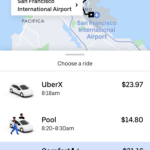Bunq lets you track and settle up group expenses
Fintech startup Bunq is announcing a handful of new features today, such as a way to track group expenses without creating a joint account, a web app and better Siri integration.
If you usually track vacation expenses and group expenses from your phone, chances are you’ve been using two different products — a mobile app like Splitwise to track group expenses with your friends, and a peer-to-peer payment app to settle up balances.
Bunq is essentially bundling these two features with Slice Groups for owners of the Bunq Travel Card. Given that the Bunq app already lists all your transactions, adding transactions to a group is easier than with your average group payment tracking app.
After adding other people to your Slice Group, each person can add expenses to the group. You get a list of your most recent Bunq transactions and you can add them to a group. You also can add manual transactions in case you paid for something using cash, for instance.
This is just a group accounting feature. When you add a transaction to a Slice Group, your money remains in your account. But you can see who has a positive balance and who has a negative balance.
When you settle up a group, people who owe money get a push notification. They can then tap on the notification and send money from their Bunq account to your friends’ Bunq accounts.
This feature will work particularly well for groups of people who all use the Bunq Travel Card. But it doesn’t fundamentally change how you manage your money with groups.
Bunq now has two tiers of users. Free users get a travel card with an account that they can top up. Paid users get a full-fledged bank account with banking information.
Multiple paid users can already create joint accounts with their roommates or partner. You can then associate your Bunq card with a joint account and spend money from that joint account directly.
So if you have a Bunq Travel Card, Slice Groups are for you. If you have a Bunq bank account, joint accounts are for you.
Revolut doesn’t try to reinvent the wheel, either, as you can only split individual card transactions with other users. It could take a while to settle all transactions after a long vacation. Revolut also lets you create Group Vaults. Those are sub-accounts to put some money aside and invite other people to contribute. But only the admin can withdraw and spend money from those vaults.
N26 has promised Shared Spaces so that you can create sub-accounts and share them with other people. But the feature isn’t live yet.
Lydia’s take on group expenses works more like Bunq’s joint accounts. You can create sub-accounts and share those accounts with other people. Everyone can then top up that account and attach a payment method, such as a payment card or a virtual card in Apple Pay or Google Pay. You also can move expenses from one sub-account to another. When you’re back from vacation, you can associate your card with your personal Lydia account again.
In addition to Slice Groups, Bunq is launching a web interface to access your bank account. It works a bit like WhatsApp’s web app. You scan a QR code with your phone and you can then control the mobile app from a desktop web browser.
Bunq should also work better with Siri. You can now send money using your voice or change card settings. Finally, the startup has also made improvements to its business accounts with a few new features. For instance, you can now automatically put money aside to pay back VAT later down the road.
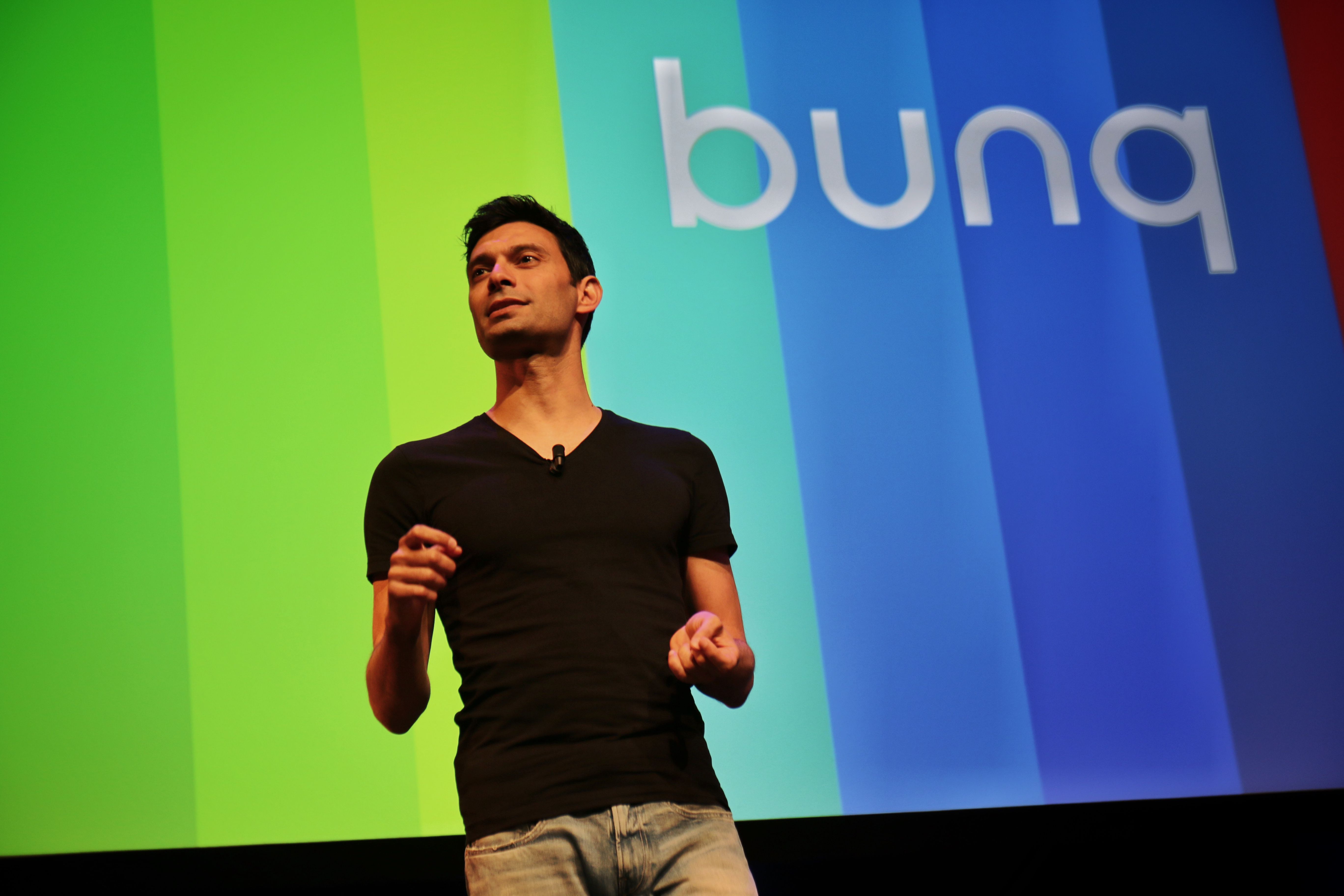
Powered by WPeMatico
AppLovin acquires SafeDK to improve brand safety
Mobile marketing company AppLovin is announcing that it has acquired SafeDK.
While AppLovin started out as a mobile ad business, it now bills itself as “a comprehensive mobile gaming platform,” offering tools for game developers around user acquisition, monetization, analytics and (through Lion Studios, launched last year) publishing. SafeDK, meanwhile, allows developers to manage all the different SDKs on which their apps rely.
Palo Alto-headquartered AppLovin says that by incorporating SafeDK technology, it will help its publishers ensure GDPR compliance and brand safety.
It also says SafeDK will continue to support existing customers, while its headquarters in Herzliya, Israel will become AppLovin’s first office in Israel. Co-founders Orly Shoavi and Ronnie Sternberg will remain on-board as the heads of SafeDK and general managers of AppLovin Israel.
The companies are not disclosing the financial terms of the deal, except to say that it was all-cash. According to Crunchbase, SafeDK has raised a total of $5.8 million from investors, including Samsung Next Tel Aviv, Marius Nacht, StageOne Ventures and Kaedan Capital.
“We are delighted to be working with the AppLovin team to help mobile game publishers grow their businesses,” Shoavi said in a statement. “AppLovin has been a trusted partner for the biggest mobile game studios around the world and SafeDK’s technology will strengthen that trust.”
Powered by WPeMatico
Dr. Mario World now available on iOS
Nintendo’s latest mobile game is now available for iOS devices, a day before its official target launch date. The game is based on the Nintendo game created in 1990 for the NES and Game Boy, and re-released/re-made a bunch of times over the years for various Nintendo consoles.
Dr. Mario World, the iOS game available now, is, like its predecessors, a matching puzzle game in which you as Dr. Mario (or maybe you’re just a colleague of Dr. Mario? It’s somewhat unclear) cure “viruses” by matching pill colors to the little jerks. This version has a number of additional gameplay features compared to the first, which was pretty Tetris-like in play. It also focuses on drag-and-drop mechanics, instead of manipulating pills like Tetris blocks as they fall.
For instance, you have other doctors from the rich Mario fictional world to call upon for help, including Dr. Peach and Dr. Bowser, as well as assistants, including Goomba, Koopa Troopa and others who apparently never either attained or aspired to professional medical doctor status. These have different skills that can make virus busting easier, and Nintendo plans to update the game with fresh doctors and assistants regularly.
Multiplayer is also part of Dr. Mario World, and you can go head-to-head or work together. Predictably, if you’ve followed Nintendo’s foray into mobile titles, this one is free-to-play, with in-game purchases for unlocking more play time and unlacing additional characters and upgrades.
Powered by WPeMatico
BMW unveils the first all-electric Mini with the Cooper SE
The all-electric Mini Cooper was once just a demonstration car and a dream for EV fans, but now it’s a car people will actually be able to buy, with truly competitive range and a ground-up purely electric drivetrain. The new Mini Cooper SE is the brand’s first purely electric small car, with a range of between 235 and 270 kilometres (146 to 168 miles) and a fast-charging possible at up to 50 kW.
The Cooper SE can also manage zero to 60 acceleration in just over seven seconds, and has an engine under the hood that’s capable of delivering the equivalent of up to 181 HP. You’ll get that instant acceleration, which is a natural benefit of all-electric engines, and a really quick jump off the line to 37 mph in just 3.9 seconds.
Of course, these performance numbers don’t match up to something like the Tesla Model S (or even the Model 3, for that matter) and the range likewise isn’t quite on par, which may be its biggest challenge. But the classic three-door Mini Cooper design is a draw in itself, and the pricing on the vehicle is around $36,400 U.S. when converted from the €32,500 starting cost, which could make it attractive for buyers at the entry-level of the luxury scale.
Meanwhile, this is also the first electric car in the BMW Group family that offers the driver a choice between full regenerative breaking or light, meaning you can tweak how aggressively the vehicle decelerates when you take your foot off the gas. It’s another nice option for people switching from gas cars, or who just like to be able to tune performance as much as possible.
BMW Group says it’s going to start shipping these ASAP, with a likely delivery date of March 2020, and already has extensive interest from pre-registered customers.
Powered by WPeMatico
If you’ll pay more, new Uber Comfort offers Quiet Rides
You can get access to Uber’s controversial Quiet Ride button that lets you ask your driver for silence if you’ll pay a 20% to 40% premium atop the UberX price. Today the Uber Comfort tier launches in 43 cities and smaller states in the U.S. plus Ottawa, offering those willing to pay the premium access to newer mid-size cars with more legroom, higher-rated drivers and Rider Preferences for requesting specific climate control or no talking.
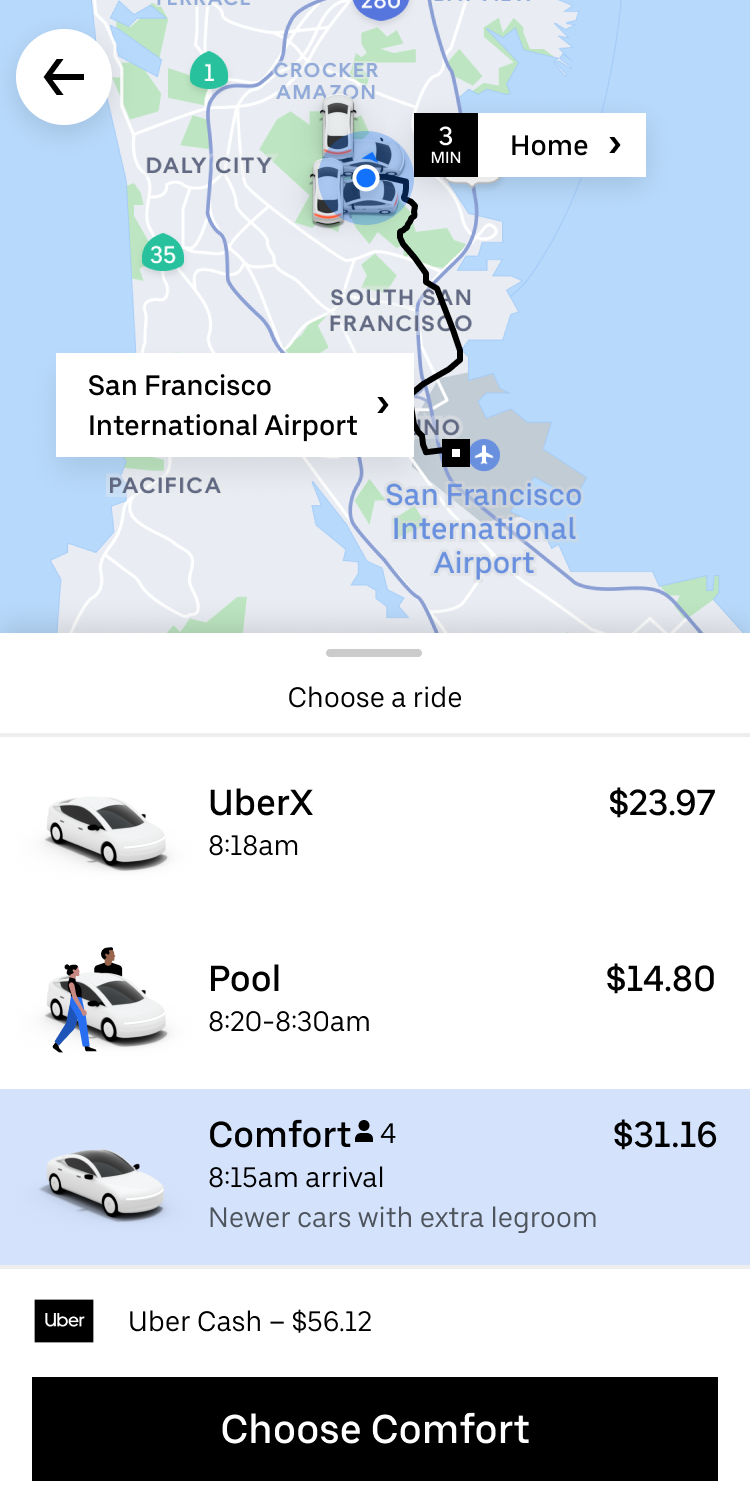 Before users hail an Uber Comfort car, they can request “quiet preferred,” “happy to chat” or leave the default of “no preference,” as well as warmer or colder temperature settings. These Rider Preferences launched in May as part of Uber’s pricier Black and SUV cars alongside a way to request help with luggage, but now they’re becoming more affordable.
Before users hail an Uber Comfort car, they can request “quiet preferred,” “happy to chat” or leave the default of “no preference,” as well as warmer or colder temperature settings. These Rider Preferences launched in May as part of Uber’s pricier Black and SUV cars alongside a way to request help with luggage, but now they’re becoming more affordable.
The move allows Uber to charge more for slightly better vehicles and higher-rated drivers that used to be lumped in with its budget UberX tier. This also lets Uber compensate drivers better if they’re willing to forgo the small talk or crank the air conditioning. “Uber Comfort should result in fares for drivers that are at least 20% higher than UberX (not including surge or promotions) for a trip with the same time and distance,” an Uber spokesperson tells me.
Some critics consider the Quiet Ride button an affront to the dignity of Uber’s contractors, saying it makes them act like robots when their jobs will soon be threatened by self-driving vehicles. But others just see it as enhanced customer service that’s reasonable to request, given riders are paying for a driver’s professional services.
“The reception to Quiet Mode has been generally positive among drivers and riders,” an Uber spokesperson tells me. “Riders appreciate the consistency and control they have over the type of their travel; business travelers in particular have shared how rider preferences have helped them be more productive en route to the airport, important meetings, or other work-related destinations. Drivers have shared how these new rider preferences have helped take the guesswork out of riders’ expectations, and helped them provide the best service possible.” They also noted that Quiet Mode is described in app as a “conversation preference” rather than a firm mandate to be silent.
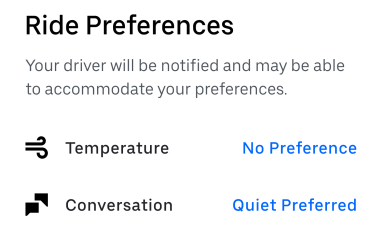
To qualify for Uber Comfort, drivers need a car that meets higher and consistent vehicle make, model, year and legroom requirements, like the Toyota Camry, Honda Odyssey or Chevy Tahoe. They also must maintain a 4.85 or higher rating to be eligible. If these drivers don’t want to receive Rider Preferences requests, they can opt out of being classified as Uber Comfort.
Uber Comfort is now available in San Francisco, Los Angeles, Chicago, Washington, DC, Atlanta, Austin, Baltimore, Boston, Charleston, Charlotte, Dallas, Fresno, Hampton Roads, Houston, Honolulu, Indianapolis, Kansas City, Las Vegas, Madison, Memphis, Milwaukee, Nashville, New Orleans, Omaha, Orange County, Palm Springs, Phoenix, Pittsburgh, Portland, Raleigh-Durham, Richmond, Sacramento, Salt Lake City, San Antonio, San Diego, Seattle, St. Louis, Tampa Bay, Tucson and Wichita, plus Ottawa, Canada, as well as the full states of Connecticut, New Jersey and Rhode Island.
Here’s the breakdown of Uber’s tiers from cheapest to most expensive:
- Uber Express Pool – The least pricey shared rides where you have to walk a few blocks
- Uber Pool – Cheaper shared rides
- UberX – Private rides without extra Rider Preferences or better vehicles
- UberX Diamond – Better-rated drivers and occasionally nicer cars but no Rider Preferences for top Uber Rewards loyalty members for no extra cost
- Uber Comfort – 20% to 40% more than UberX for Rider Preferences like Quiet Rides plus better-rated drivers, nicer cars and minimum legroom requirements
- Uber Select – Even more expensive for high-end cars but no Rider Preferences
- Uber Black & SUV – The highest price for Rider Preferences, including luggage help and premium town cars or big vehicles
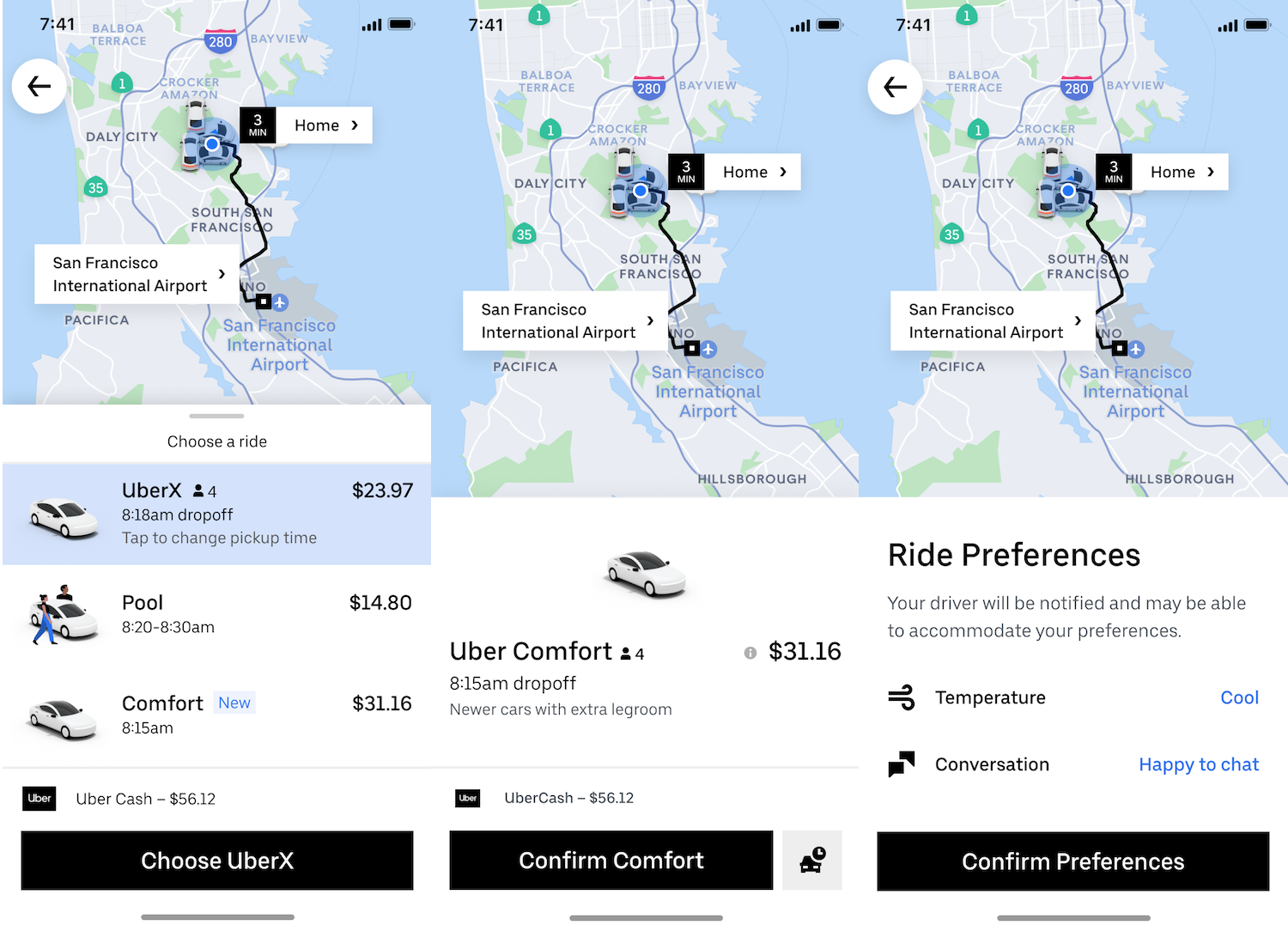
Back in December, I recommended Uber add a Quiet Ride option that can be nice if you’re trying to work or rest during your trip. Users told me it was awkward having to ask drivers mid-ride for quiet, as some would become offended or even hostile.
That’s especially problematic for women, some who said their male drivers’ probing questions would escalate to unwanted flirtation. Uber needs to do better at training drivers that this is unacceptable and weed them out of the system. But the reactive approach of waiting for negative ratings to come in after drivers have annoyed passengers can be augmented by allowing riders to ask for quiet ahead of time.
Bringing Rider Preferences to a wider swath of its vehicles could help Uber differentiate itself from competitors like Lyft and squeeze more cash out of passengers by training them to use its upgraded tiers as it tries to maintain momentum in the public market. Two months after its IPO, it’s finally recovered and exceeded its opening price.
Powered by WPeMatico
Facebook will start taking a cut of fan subscriptions in 2020
Facebook will take a cut of up to 30% on fan subscriptions, beginning on January 1, 2020.
The social network is revealing its plans as part of a broader slate of monetization-related announcements this week at VidCon. The news confirms a TechCrunch report earlier this year that Facebook would be taking a 30% share of subscription revenue.
Facebook first started rolling out fan subscriptions in early 2018, allowing creators to charge their fans $4.99 per month in exchange for access to exclusive content and a fan badge. During this initial testing period, Facebook didn’t keep any of the subscription revenue for itself, allowing creators to take everything, minus the fee collected by Apple and Google on mobile subscriptions.
Director of Media Monetization Kate Orseth told journalists at a briefing last week that Facebook is committed to allowing creators to keep 70% of subscription revenue (minus “applicable taxes and fees”). So when the mobile platforms collect their 30% fee on first-year subscriptions, Facebook won’t take a cut. Then, as the platforms lower their share to 15% in the second year, Facebook will take the other 15%.
Again, that’s all on mobile, which Orseth said represents the majority of subscriptions thus far. On desktop, Facebook will be able to take the full 30% from the start. (This compares to a 5% subscription fee collected by Patreon, a 30% fee collected by YouTube and a 50% fee collected by Twitch.) And Orseth noted that all of this only applies to new subscribers starting in January — Facebook won’t be taking a revenue share on subscribers who signed up before then.
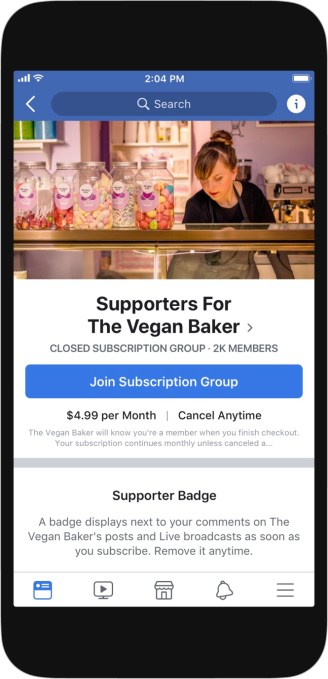
In addition, Facebook says it’s allowing creators to launch exclusive groups for subscribers. And it’s expanding the Facebook Stars program, the virtual currency that allows users to tip game streamers — it’s now testing the feature with non-gaming video creators. The company says creators should earn 1 cent for each Star a fan sends them. And yes, Facebook is also taking a cut here, though it says its share decreases as fans buy larger packs of Stars.
Facebook is also making a number of ad-related announcements. Among them: creators will be able to limit ads on a video to “non-interruptive” formats like pre-roll and image ads, so there are no ad breaks inserted. In addition, they’ll be able to share their audiences with advertisers in the Brand Collabs Manager for ad targeting. And they can start viewing their Instagram data in Facebook’s Creator Studio.
Orseth said the company’s goal is “to create a suite of monetization products that can be used individually” or in a bundle. She suggested that while ad breaks work best for creators with a broad audience, subscriptions are better for those with a “hyperloyal audience” and brand collaborations “work well across the board.”
As part of the briefing, Orseth introduced journalists to Mark Ian Hoyle and Roxanne Hoyle, the parents behind the popular LadBaby Facebook Page, where they share videos of their family and children. The Hoyles said that by using the full suite of Facebook monetization tools, they’ve been able to focus on making videos (Mark still works as a freelance graphic designer, as well), and to afford trips to make more videos.
Given the broader controversies over who gets to make money on major online platforms, Orseth and the Facebook team were also asked about eligibility for monetization. The company says that each product has its own eligibility requirements, and that for now, humans are reviewing each application to participate in the Brand Collabs Manager and Fan Subscriptions.
Powered by WPeMatico
India’s NiYO ‘neo-bank’ raises $35M to help blue-collar workers access financial services
NiYO Solutions, a Bangalore-based “neo-bank” that helps salaried employees and blue-collar workers access company benefits and other financial services, has raised $35 million in a new funding round to expand its business in the nation and explore international markets for some of its products.
The four-year-old startup, which serves small and medium businesses and other salaried employees across India, raised its Series B from Horizons Ventures, Tencent and existing investor JS Capital. It has raised $49.2 million to date, with its $13.2 million Series A closing in January last year.
NiYO Solutions serves as a “neo-bank” that relies on traditional financial institutions (Yes Bank and DCB banks, in its case) and offers to customers additional features such as lending and insurance. Blue-collared employees in India (and many other markets) continue to struggle in availing crucial financial services from banks that typically reserve them for the privileged segment. With its payroll solution and other products, NiYO is trying to drive financial inclusion in the country, it said.
The startup also offers a global travel card with no mark-up fee. More than 50,000 users have already signed up for the travel card — and NiYO intends to scale that figure to 500,000 by April next year. In an interview with TechCrunch, Vinay Bagri, co-founder and CEO of NiYO, said the startup is exploring bringing the travel card to other markets — though he did not share any names.
He said the startup will also use the fresh capital to build new product offerings and in expansion of its distribution and marketing efforts. It also wants to grow its customer base from about 1 million currently to 5 million in the next three years. Bagri said NiYO is looking to acquire other startups that are a good fit for its vision.
Neo banks are increasingly becoming popular across the globe as traditional banks show little interest in addressing the needs of niche customer bases. Tide and N26 are showing remarkable growth in European markets, while Azlo in the U.S. and Tyro Payments and Volt Bank in Australia are also among the top players.
In developing regions such as India, too, this tried and tested idea is increasingly being replicated. Open, another Bangalore-based neo-bank, helps businesses automate their finances. It raised $30 million last month.
Powered by WPeMatico
India’s Android antitrust case against Google may have some holes
India ordered an investigation into Google’s alleged abuse of Android’s dominance in the country to hurt local rivals. A document made public by the local antitrust watchdog has now further revealed the nature of the allegations and identified the people who filed the complaint.
Umar Javeed and Sukarma Thapar, two associates at Competition Commission of India — and Aaqib Javeed, brother of Umar and who interned at the watchdog last year, filed the complaint, the document revealed. The revelation puts an end to months-long interest from industry executives, many of whom wondered if a major corporation was behind it.
The allegations
The case, filed against Google’s global unit and Indian arm on April 16 this year, makes several allegations, including the possibility that Google used Android’s dominant position in India to hurt local companies. The accusation is that Google requires handset and tablet vendors to pre-install its own applications or services if they wish to get the full-blown version of Android . Google’s Android mobile operating system powered more than 98% of smartphones that shipped in the country last year, research firm Counterpoint said.
This accusation is partly true, if at all. To be sure, Google does offer a “bare Android” version, which a smartphone vendor could use and then they wouldn’t need to pre-install Google Mobile Services (GMS). Though by doing so, they will also lose access to Google Play Store, which is the largest app store in the Android ecosystem. Additionally, phone vendors do partner with other companies to pre-install their applications. In India itself, most Android phones sold by Amazon India and Flipkart include a suite of their apps preloaded on the them.
“OEMs can offer Android devices without preinstalling any Google apps. If OEMs choose to preinstall Google mobile apps, the MADA (Mobile Application Distribution Agreement) allows OEMs to preinstall a suite of Google mobile apps and services referred to as Google Mobile Services (GMS),” said Google in response.
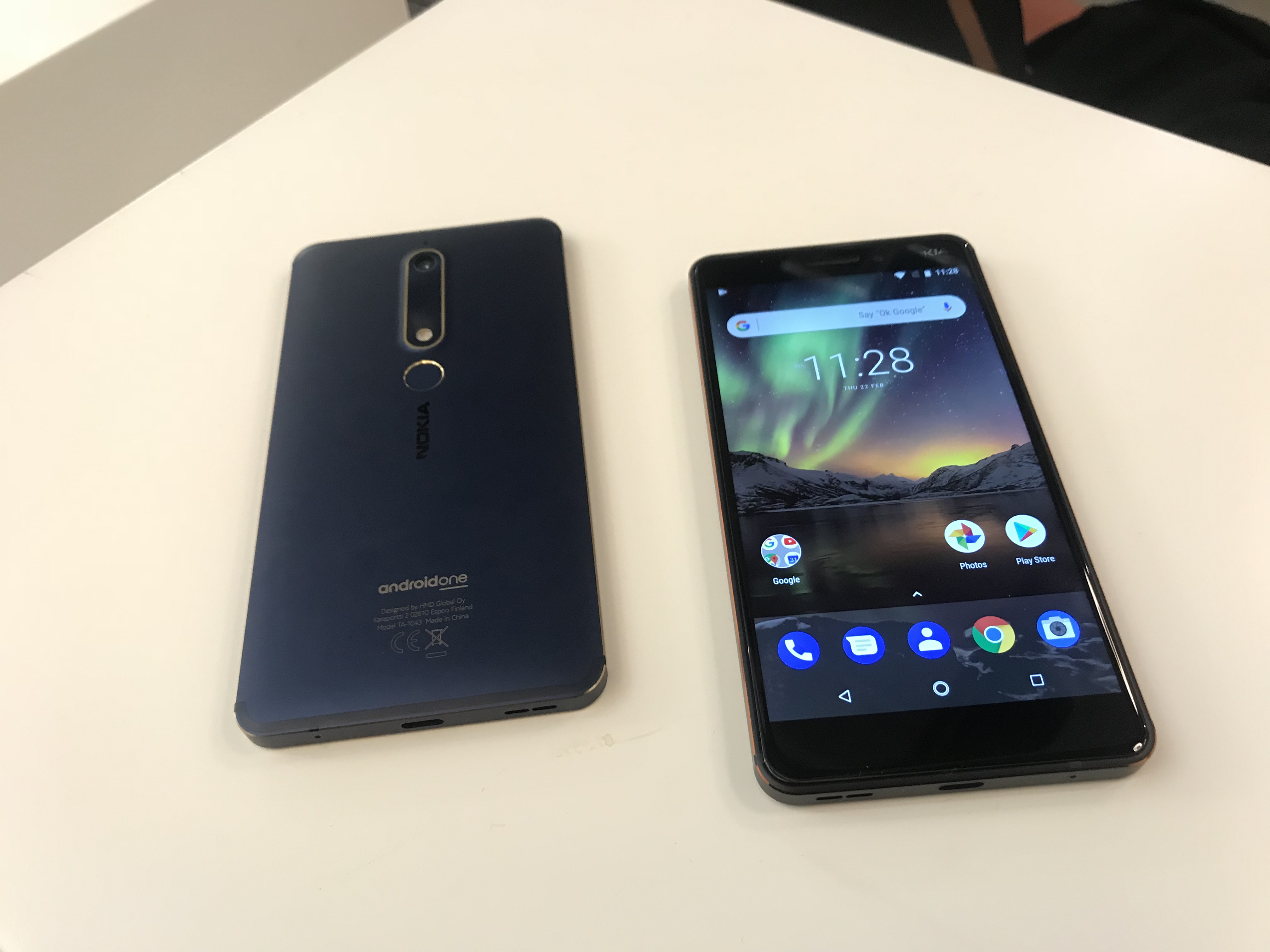
The second allegation is that Google is bundling its apps and services in a way that they are able to talk to each other. “This conduct illegally prevented the development and market access of rival applications and services in violation of Section 4 read with Section 32 of the Act,” the trio wrote.
This also does not seem accurate. Very much every Android app is capable of talking to one another through APIs. Additionally, defunct software firm Cyanogen partnered with Microsoft to “deeply integrate” Cortana into its Android phones — replacing Google Assistant as the default virtual voice assistant. So it is unclear what advantage Google has here.
Google’s response: “This preinstallation obligation is limited in scope. It was pointed out that preinstalled Google app icons take up very little screen space. OEMs can and do use the remaining space to preinstall and promote both their own, and third-party apps. It was also submitted that the MADA preinstallation conditions are not exclusive. Nor are they exclusionary. The MADA leaves OEMs free to preinstall rival apps and offer them the same or even superior placement.”
The third accusation is that Google prevents smartphone and tablet manufacturers in India from developing and marketing modified and potentially competing versions of Android on other devices.
This is also arguably incorrect. Micromax, which once held tentpole position among smartphone vendors in India, partnered with Cyanogen in their heyday to launch and market Android smartphones running a customized operating system. Chinese smartphone vendor OnePlus followed the same path briefly.
Google’s response: “Android users have considerable freedom to customise their phones and to install apps that compete with Google’s. Consumers can quickly and easily move or disable preinstalled apps, including Google’s apps. Disabling an app makes it disappear from the device screen, prevents it from running, and frees up device memory – while still allowing the user to restore the app at a later time or to factory reset the device to its original state.”
Additionally, Google says it requires OEMs to “adhere to a minimum baseline compatibility standard” for Android called Compatibility Definition Document (COD) to ensure that apps written for Android run on their phones. Otherwise, this risks creating a “threat to the viability and quality of the platform.”
“If companies make changes to the Android source code that create incompatibilities, apps written for Android will not run on these incompatible variants. As a result, fewer developers will write apps for Android, threatening to make Android less attractive to users and, in turn, even fewer developers will support Android,” the company said.
The antitrust is ongoing, but based on an initial probe of the case, CCI has found that Google has “reduced the ability and incentive of device manufacturers to develop and sell devices” running Android forks, the watchdog said. Google’s condition to include “the entire GMS suite” to devices from OEMs that have opted for full-blown a version of Android, amounts to “imposition of unfair condition on the device manufacturers,” the watchdog added.
The document also reveals that Google has provided CCI with some additional responses that have been kept confidential. A Google spokesperson declined to comment.
Powered by WPeMatico
Y Combinator-backed Project Wren is aiming to make carbon offsets more consumer friendly
When Landon Brand and Benjamin Stanfield graduated from the University of Southern California this year, they already had the plans for Project Wren, their service for selling carbon offsets to a new generation of conscious consumers.
Along with fellow co-founder Mimi Tran Zambetti (who’s still attending USC), Brand and Stanfield aim to make carbon offsets more accessible to people who may feel like there’s nothing they can do on a personal level to reduce their carbon footprint or support projects that reduce carbon emissions.
It’s not a novel concept. In 2004, TerraPass launched its service to provide carbon offsets for consumers. The company was acquired in 2014 and now operates as a subsidiary of the publicly traded Canadian retail energy company, Just Energy.
Since TerraPass, other organizations have come in with services to offset consumer and corporate carbon emissions. The Swiss nonprofit MyClimate is another organization working on offsets for corporations and individuals (as is the German nonprofit, Atmosfair) and the North American public benefit corporation, NativeEnergy also has both a retail and corporate offset program.
Project Wren sources its offset investments from Project Drawdown and is trying to choose the projects that the company’s founders consider “most additional,” according to Brand.
Brand, Stanfield and Tran Zambetti met at USC while pursuing a bachelor of science degree in USC’s new Jimmy Iovine and Andre Young Academy. Iovine and Young are the co-founders of Beats, which sold to Apple for roughly $3 billion, but perhaps are more famous for their work in the music business as the co-founders of Interscope Records (Young is the rapper and producer known as Dr. Dre).
From the outset the three students worked together on side projects and in student organizations, and decided last year to launch a sustainable business that could impact consumers in a positive way. The first idea, and the one that was initially incorporated as Project Wren, was to develop an algorithmically enhanced software service to promote diversity and inclusion in companies.
“The idea was promising, but it’s a hard product to sell. Companies aren’t used to leveraging software to help build their culture,” Brand wrote in an email. “Trying to get people to use the product made us realize how difficult it is to build something that’s useful and good for the world. If we were going to build a company around doing good, it would take a decade or more.”
The group convened earlier this year and decided, after spending a year working on their idea, that the more than 10 years it would take to build a successful business was too long for them to see the impact they wanted to make in the world. “We felt like the mission of making companies a better place to work was important, but not urgent,” Brand wrote to me in an email. “Climate change is urgent. It’s the biggest challenge humanity has ever faced. That’s why we decided to pivot.”
The group then decided that they would pool their resources on another project — a vegan cloud kitchen that could potentially become a franchise or chain.
“Meat production is responsible for as much as 20% of greenhouse gas emissions,” Brand wrote. “If we could make eating vegan food easier than eating meat, we would have a huge impact.”
The group ran a cloud kitchen out of Brand’s apartment for two weeks before deciding that, too, ultimately was a wash for the three young co-founders.
With that idea behind them, the three began researching carbon offsets, which led them to Project Drawdown, which led them to build their current website and, ultimately, Y Combinator .
Customers who buy offsets using Wren will support projects that the company has selected for their additionality (meaning the projects would not have been done without the support of organizations like Wren). Once the offsets are purchased, Project Wren retires them from circulation so they can’t be traded on any exchange after their creation.
The company makes money by taking a 20% commission above the price of the project for operating expenses and marketing, says Brand.
What Brand sees as the young company’s competitive advantage is its ability to communicate more directly with a new audience of offset acquirers — engaging them more in the process by providing updates on the project.
“Photos, and stories too, from people on the ground will add a more human, real, touch,” to the projects and their reporting back to carbon offset buyers, according to Brand. “We just talk to a bunch of potential partners and see which partners would be able to give unique compelling updates to our users.”
Powered by WPeMatico
HQ Trivia has paid out $6M, but winners complain of delays
HQ Trivia’s troubles continue after a failed mutiny to oust the CEO, a 92% decline in downloads since versus a year ago, and layoffs of 20% of its staff last week. Now TechCrunch has learned HQ has failed to install a new CEO after months of searching. Meanwhile, users continue to complain about delays for payouts of their prizes from the live mobile trivia game, and about being booted from the game for no reason while on the final question.
Notably, Jeopardy winner Alex Jacob claims he hasn’t been paid the $20,000 he won on HQ Trivia on June 10th. This could shake players faith in HQ and erode their incentive to compete.
Guys, I need your help. I won $20,000 on @hqtrivia on June 10 and still haven’t heard anything about payment. Sadly, I don’t think they’re going to pay.
Please RT to tell HQ they should honor their jackpots. If I’m wrong, I’ll happily delete this & give $100 to someone who RT’d! pic.twitter.com/FmpY6unK49
— Alex Jacob (@whoisalexjacob) July 8, 2019
An HQ Trivia representative tells TechCrunch that the game has paid out $6.25 million to date and that 99% of players have been eligible to cash out within 48 hours of winning, but some winners may have to wait up to 90 days for it to ensure they didn’t break the rules to win. Given Jacob’s large jackpot, it’s possible the delay could be due to the company investigating to ensure he won fairly, though he’s clearly skilled at trivia given he won Jeopardy’s Tournament Of Champions in 2015. Jacob did not respond to requests for interview.
“We strive to make a game that is fair and fun for all players. As such, we have a rigorous process of reviewing winners for eligibility to receive cash prizes. Infrequently, we disqualify players for violating HQ‘s Terms of Service and Contest Rules” HQ Trivia’s press alias anonymously reponded to our request for comment. “It may take some eligible winners up to 90 days to receive cash prizes, however 99% of players have been able to cash out within 48 hours of winning a game and we have paid out a total of $6,252,634.58 USD to winners since launch.”
It seems that HQ’s internal problems are now metastasizing into public issues. Its team being short-staffed and distracted by weak morale could lengthen payout delays, which make players worry if they’ll ever get their cash. When they share those sentiments to social media, it could discourage others from playing. That, combined with concerns that bots and cheaters are winning the games, splitting the jackpots into tiny fractions so legitimate winners get less, has hurt the perception of HQ as a game where the smartest can win big.
Back in April, TechCrunch reported that 20 of HQ’s 35 staffers were preparing a petition to the board to remove CEO and co-founder Rus Yusupov for mismanagement. Yusupov caught wind of the plot and fired two of the leaders of the movement. However, HQ’s board decided it would bring in a new CEO. Board member and Tinder CEO Elie Seidman told TechCrunch that Yusupov had accepted he would be replaced by someone with the ability fire him and that a CEO search was ongoing. The startup’s lead investor Lightspeed has pledged to provide 18 months of funding once a new CEO was hired.
However, multiple sources tell TechCrunch that a new CEO has yet to be installed. One source tells me that management had promised a new CEO by the beginning of August, but that Yusupov had stalled the process seemingly to remain in power. HQ Trivia, Yusupov, and Seidman did not respond for requests for comment regarding the CEO search.
When asked about morale at the company, a source familiar with HQ’s internal situation told me “It’s terrible.” Yusupov is said to continue to be tough to work with, making decisions without full buy-in from the rest of the company. A substantial portion of the team was allegedly unaware of plans to launch a $9.99 subscription tier for HQ’s second game HQ Words until the company tweeted out the announcement.
Hopefully HQ Trivia can find a new captain to steer this ship back into smoother waters. The game has hundreds of thousands of players and many more with fond memories of competing. There’s still hope if it can evolve the product to give new users a taste of gameplay without waiting for the next scheduled match, find new revenue in expanded brand partnerships, fight off the bots and cheaters, and get everyone paid promptly. Perhaps there’s room for television tie-ins to bring HQ to a wider audience.
But before the startup can keep quizzing the world, HQ Trivia must endure its internal tests of resolve and find a champ to lead it.

Powered by WPeMatico

